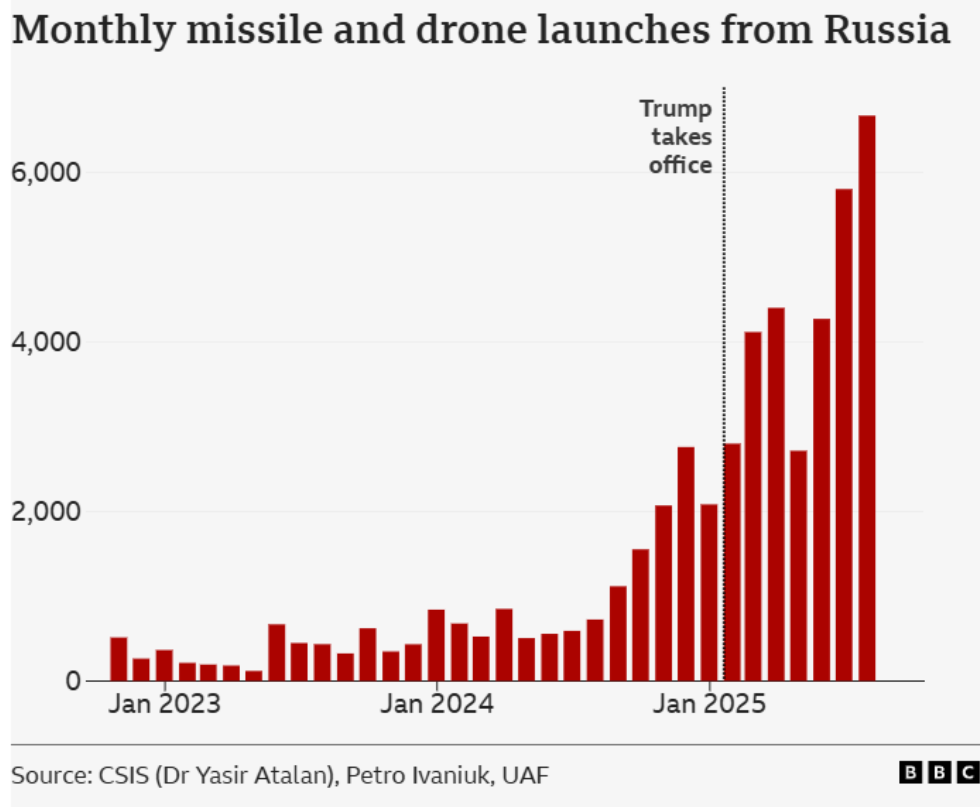Russia has sharply escalated missile and drone strikes on Ukraine since Donald Trump took office in January 2025, with launches doubling to nearly 7,000 per month. Critics argue Vladimir Putin sees Trump as unwilling to hold him accountable, allowing Moscow to press for maximalist terms in any future negotiations. Instead of strengthening Ukraine’s position, Trump’s stance risks forcing Kyiv into surrender on Putin’s terms.
Russia’s Missile and Drone Attacks on Ukraine Surge Twofold Since
Since Donald Trump returned to the White House in January 2025, Russia has dramatically escalated its war in Ukraine. New data on missile and drone launches paints a stark picture: far from winding down its aggression, Moscow has more than doubled its monthly attacks. This trend underscores a troubling reality — Vladimir Putin sees Trump as a leader unwilling to hold him accountable, and he is exploiting that perception to intensify Russia’s campaign.
According to figures compiled by CSIS, Petro Ivaniuk, and the Ukrainian Air Force, Russia averaged under 1,000–1,500 launches per month through much of 2023. The numbers crept higher in late 2024, but after Trump took office in January 2025, the escalation became undeniable. In the months that followed, launches surged past 4,000 per month and most recently spiked to nearly 7,000. This sharp upward trend coincides almost perfectly with Trump’s inauguration, suggesting that Russia has interpreted the political shift in Washington as a green light for more aggressive action.

The logic behind Putin’s escalation is not hard to decipher. Trump has repeatedly signaled skepticism about U.S. aid to Ukraine, questioning why American taxpayers should fund Kyiv’s defense and hinting that Ukraine might be better off negotiating directly with Russia. While Trump portrays this stance as pragmatism, Moscow likely interprets it as weakness. Putin, a leader who thrives on testing Western resolve, appears to have concluded that Trump will not impose meaningful consequences for Russia’s continued aggression. Instead, flattery, back-channel praise, and the illusion of a potential “deal” may be all it takes to keep Trump disengaged from Ukraine’s struggle.
For Ukraine, this shift could not come at a worse time. The country has held out against Russia’s larger military thanks in large part to consistent Western support, especially U.S. military assistance. Precision weapons, air defense systems, and intelligence sharing have all played critical roles in preventing Russia from achieving its territorial ambitions. But if Washington withdraws or limits its backing, Kyiv could find itself cornered, not in a position of strength, but of desperation.
That is precisely why critics argue Trump’s current approach is undermining the very goal of achieving peace. If he were truly interested in ending the war, he would be working to ensure Ukraine enters negotiations from a position of leverage, not vulnerability. History shows that authoritarian leaders like Putin exploit weakness at the negotiating table, pressing for maximalist terms when they sense their adversary has no choice but to concede. A handcuffed Ukraine — cut off from its most important ally — would be forced to swallow terms that could amount to a de facto surrender, legitimizing Russia’s territorial seizures and rewarding military aggression.
Putin knows this dynamic well. He also knows that prolonging the war serves his broader geopolitical interests. By keeping Ukraine unstable, he undermines Kyiv’s path to European Union and NATO integration. By stretching Western resources, he tests the resilience of the transatlantic alliance. And by exploiting Trump’s ambivalence, he increases the odds of fracturing U.S.-European unity. For Moscow, this is not just about battlefield victories, but about rewriting the security architecture of Europe to suit Russian interests.
Meanwhile, Ukrainians continue to pay the price in lives lost, infrastructure destroyed, and cities under siege from near-daily missile and drone strikes. Each spike in Russia’s launch statistics translates into real suffering on the ground — power stations destroyed, apartment blocks reduced to rubble, and civilians killed in their homes. The escalation since Trump’s inauguration is not just a set of numbers on a chart; it is evidence of a worsening humanitarian catastrophe fueled by geopolitical miscalculation.
The central question now is whether Trump will continue down this path of disengagement. His supporters argue that his strategy is about pushing Ukraine toward a negotiated settlement, one that could end the war sooner than years of continued fighting. But critics counter that such a settlement, under current conditions, would not be peace — it would be capitulation. It would entrench Russia’s gains, embolden Putin, and send a signal to other authoritarian regimes that military aggression pays off.
If Trump truly wants to prove he can end the war, he must ensure that Ukraine negotiates from strength, not weakness. That means continuing, not cutting, U.S. support. It means coordinating with European allies rather than undermining them. And it means showing Putin that escalation will not be rewarded, but punished. Anything less risks making Trump not the dealmaker he aspires to be, but the unwitting enabler of Russia’s most dangerous ambitions.
For now, the evidence is clear: Putin believes Trump is a pushover, and Russia’s missiles and drones are flying at record rates as a result. Unless the U.S. recalibrates its approach, Ukraine may soon find itself cornered into a settlement that secures Putin’s vision of conquest rather than Ukraine’s right to sovereignty. The stakes could not be higher — not just for Kyiv, but for the future of international security itself.

